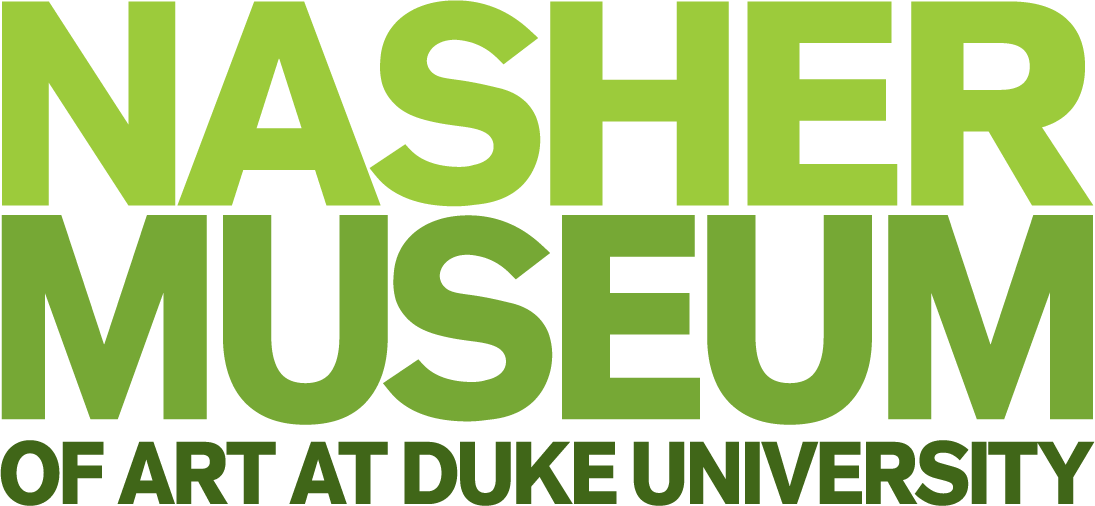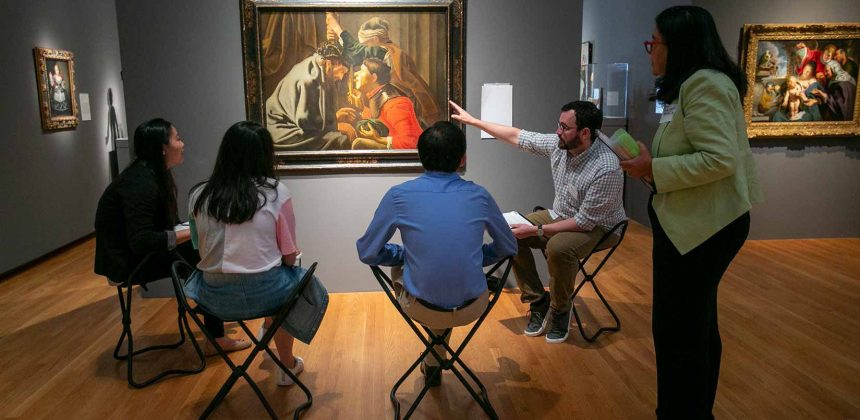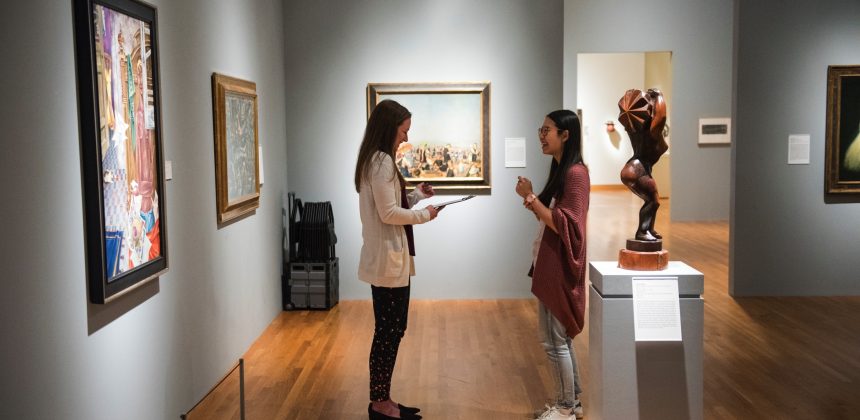Teaching at the Museum
We invite university classes and professional schools to visit during regular museum hours, following relevant health and safety protocols. Registration, although not required to visit the museum, is strongly encouraged.
Learn About the Collection
Only a small portion of the museum’s permanent collection is on view at any time, so a variety of tools are available to help you explore the works of art in the Nasher’s collection, whether currently on view or in storage.
Browse the Nasher Museum collection.
Information about art in a range of media, styles, periods, and cultures can be found at our website promoting visual literacy: How Do You Look? [temporarily unavailable]
Browse the Collection Up Close
The Nasher Museum has joined Google Arts & Culture, which offers virtual experiences of thousands of the world’s great museums. Download the app for free or visit from your desktop and zoom in close to view important works in our collection. The Nasher is excited to have brought many of these artists to Google Arts & Culture for the first time.Object-Based Lesson Plans
Welcome to our Lesson Plans, a collection of teaching resources inspired by the Nasher Museum’s collect...
Published
Ways to Engage

The following ideas can be adapted to a wide range of course themes and critical issues:
[bg_collapse view=”link” color=”#4a4949″ expand_text=”Show More” collapse_text=”Show Less” ]
Caption It
Students identify works that illustrate key concepts from class (this is about looking and relating, not finding a right answer). They write a headline and an image caption to explain the connection. Students present their captions in small groups and select one to present to the class. The class identifies the work and caption they feel best illustrates the concept. Excellent for testing conceptual understanding and application.
What’s Your Issue?
Instructors identify issues explored in the course and choose corresponding artworks from the collection. Small groups are given an issue and relevant background material on the artwork. The students must discuss their issue in relation to the image or object and formulate a short presentation. Images can be provided for class presentations or students can photograph works with their smartphone. Review our photo policy.
R.S.V.P.
Students are presented a set of cards, each bearing a symbol that communicates a possible response to a particular work or its theme (love/hate/confusion, agree/disagree). Next, as they navigate the gallery, students must choose and note which works match a particular response by placing the corresponding card in front of the work. Works with the most cards become the subject of group discussion, as students explain their choices. Excellent practice for visual analysis and verbalising the visual. Language courses: good for conversation and practicing the subjunctive.”
Find and Seek
Each student selects a work to write a short descriptive paragraph about. After completing their descriptions, have students exchange drafts with a partner. Each student is then charged with finding their partner’s work. Once correctly identified, have students write their own response to the work. Excellent practice for visual analysis, verbalizing the visual, and visual critique. Language courses: good for practicing vocabulary, grammar and expressing emotions and preferences.
Consider the Context
Students choose an artwork and, relying on close visual examination, consider their personal response (how they feel about the work and why they think that is) and the relationships between the art and its setting (what other works are displayed nearby, what are the relationships between them?). After reading the object label or background information, they evaluate how the work relates to its time period, cultural movement or a critical issue. They share their responses with classmates. Helpful for exploring opinion versus fact, and applying critical concepts to visual material.
Label Talk
Explore multiple viewpoints in a variety of ways and practice respectful discourse and dialogue.
- Choose one work of art for all students to write short personal responses (250 words). After sharing, they comment on one another’s perspectives, discussing commonalities and differences in approaches.
- One theme or concept is selected and students are asked to identify a work of art that best expresses or elaborates upon that topic. This is a good way to test their mastery of the concept and critical skills by having them apply a new form of analysis to the work (i.e., visual, rather than textual). Group discussion focuses on the variety of choices and possible differences in interpretation.
- Students each choose one work of art and write multiple short responses from a variety of views or utilizing different methodologies through the course of the semester (i.e., descriptive/ekphrastic, aesthetic, historical, personal, narrative, feminist, Marxist, semiotic, etc.).
Back to Back Drawing
Students are paired as viewer and listener. Viewers select a work of art and guide the listener to a position where they cannot see the work. The viewer describes the work while the listener attempts to draw it from the description. The listener is not permitted to ask for clarification, and the viewer is not allowed to see the drawing until time is up. Then the students evaluate the drawing together considering misconceptions and misunderstandings, assumptions and language choices. Excellent as a communication exercise, exploring visual language and description, and practicing foreign language skills.
Treasure Hunt
Students hunt for works by following clues and a map. To get the next clue, they must answer questions about the works they locate. Excellent for developing viewing skills and cooperative efforts. Language application: developing vocabulary, reading comprehension and writing.
Foreign Language Activities
The Nasher Museum’s permanent collection and temporary exhibitions offer many opportunities to strengthen foreign language skills. The activities listed above can all be utilized in this context. Below are additional ideas and examples made specifically with language courses in mind:
- Label Translation: Students pick any work of art on display with a label and translate it. This exercise encourages close looking and increases vocabulary.
- Writing Labels: Students pick a work of art either on display or in Study Storage and write an original label for it. Labels can be edited by the instructor and re-written for content and grammar.
- Creative Writing: Students select an artwork on display or in Study Storage that will serve as the subject of a creative essay or final paper. The paper can be worked on throughout the semester and edited as new tenses and vocabulary are taught in class.
- Vocabulary Building: Instructors provide students with vocabulary lists for specific artworks on display, which they then have to identify, OR students select a work of art and make their own vocabulary list and then discuss the image with the class using those words, OR students are given the vocabulary list for a particular artwork and then have to write a short description/paper/label using some or all of the words.
- Translation of Art: Many images in the Nasher Museum’s permanent collection contain foreign text. Students can translate the text and consider how it enhances the image’s meaning (or vice-versa).
- Description/Imagination: Students work with one image in the galleries or Study Storage. With a partner, they write down a basic description of the work, including colors, forms, subject matter, etc. Afterward, they write down what they think the image is about. When each group has finished, they present their descriptions and thoughts to the class. A great way to develop close-looking skills, vocabulary, comfort in speaking to a partner and large group, and the use of subjunctive in order to express an idea or opinion.
- Mini-presentations: In advance of the class visit, the instructor collaborates with academic program staff to create a list of works from the museum that relate to the course topic. The instructor presents the list to the students, who each select a work of art to research. For the museum visit, whether in Study Storage or the gallery, students give a mini-presentation to the class on their artwork. Excellent for developing writing and oral presentation skills, and for learning more about the target culture.
[/bg_collapse]
Need additional assistance?
If you have any questions or would like to discuss how the Nasher can support your teaching, whether in person, hybrid or online, please email Ellen C. Raimond, Ph.D., Associate Curator of Academic Initiatives, at ellen.raimond@duke.edu.
Reimagining Medicine
Duke dermatologist Lynn McKinley-Grant has found that visual art can sharpen doctors’ perceptive abilities, including helping them to see past the surface in dealing with patients. McKinley-Grant led students in observatio...
view article on Duke Stories | Published November 28, 2018
Medical Students Learn Cultural Competency, Empathy, Communication from Art
As Duke medical students learn how to examine patients in their classes, they also learn how to examine works of art at the Nasher Museum. Duke’s School of Medicine and the Nasher Museum created a program that brings medic...
Published



